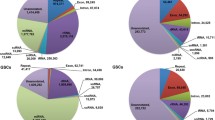Abstract
Many small RNAs have been cloned from animal gonads, for example, endogenous small interfering RNAs (endo-siRNAs) were found in oocytes and piwi-interacting RNAs (piRNAs) were found in testis. Gallus gallus (chicken) is an important model organism, but few small RNAs have been identified from its gonads. In this study, we isolated and cloned 156 small RNAs from adult chicken testes. Since there is a reasonably even distribution from 22 to 33 nt, these small RNAs are slightly longer than miRNAs and endo-siRNAs. Genome mapping indicated that these small RNAs were derived from intergenic regions, exons, introns, and repetitive elements including chicken repeat 1, long terminal repeats, and simple repeats. Since they are similar with piRNAs, we named them piRNA-like RNAs (pil-RNAs). Northern blotting of 16 selected sequences showed that nine are specifically expressed in the adult testis. The vast majority of these pil-RNAs are poorly conserved between species, suggesting that they are unique to the adult chicken testis. Further analysis of the cloned pil-RNAs will improve our understanding of the function of small RNAs in animal gonad development.






Similar content being viewed by others
References
Reinhart B, Bartel D (2002) Small RNAs correspond to centromere heterochromatic repeats. Science 297(5588):1831
Zamore P, Haley B (2005) Ribo-gnome: the big world of small RNAs. Science 309(5740):1519–1524
Lee R, Feinbaum R, Ambros V (1993) The C. elegans heterochronic gene lin-4 encodes small RNAs with antisense complementarity to lin-14. Cell 75(5):843–854
Wightman B, Ha I, Ruvkun G (1993) Posttranscriptional regulation of the heterochronic gene lin-14 by lin-4 mediates temporal pattern formation in C. elegans. Cell 75(5):855–862
Hutvagner G, Simard MJ (2008) Argonaute proteins: key players in RNA silencing. Nat Rev Mol Cell Biol 9(1):22–32
Bartel D (2004) MicroRNAs: genomics, biogenesis, mechanism, and function. Cell 116(2):281–297
Tam O et al (2008) Pseudogene-derived small interfering RNAs regulate gene expression in mouse oocytes. Nature 453(7194):534–538
Czech B et al (2008) An endogenous small interfering RNA pathway in Drosophila. Nature 453(7196):798–802
Lin H (2007) piRNAs in the germ line. Science (Washington) 316(5823):397
Hartig J, Tomari Y, Frstemann K (2007) piRNAs—the ancient hunters of genome invaders. Genes Dev 21(14):1707–1713
Watanabe T et al (2006) Identification and characterization of two novel classes of small RNAs in the mouse germline: retrotransposon-derived siRNAs in oocytes and germline small RNAs in testes. Genes Dev 20(13):1732–1743
Okamura K, Lai E (2008) Endogenous small interfering RNAs in animals. Nat Rev Mol Cell Biol 9(9):673–678
Houwing S et al (2007) A role for Piwi and piRNAs in germ cell maintenance and transposon silencing in Zebrafish. Cell 129(1):69–82
Carthew R, Sontheimer E (2009) Origins and mechanisms of miRNAs and siRNAs. Cell 136(4):642–655
O’Donnell K, Boeke J (2007) Mighty piwis defend the germline against genome intruders. Cell 129(1):37–44
Brennecke J et al (2008) An epigenetic role for maternally inherited piRNAs in transposon silencing. Science 322(5906):1387–1392
Brennecke J et al (2007) Discrete small RNA-generating loci as master regulators of transposon activity in Drosophila. Cell 128(6):1089–1103
Kato M et al (2009) Dynamic expression of small non-coding RNAs, including novel microRNAs and piRNAs/21 U-RNAs, during Caenorhabditis elegans development. Genome Biol 10(5):R54
Nishida KM et al (2007) Gene silencing mechanisms mediated by Aubergine piRNA complexes in Drosophila male gonad. RNA 13(11):1911
Lau N et al (2006) Characterization of the piRNA complex from rat testes. Science 313(5785):363–367
Girard A et al (2006) A germline-specific class of small RNAs binds mammalian piwi proteins. Nature 442(7099):199–202
Aravin A et al (2006) A novel class of small RNAs bind to MILI protein in mouse testes. Nature 442:203–207
Grivna ST et al (2006) A novel class of small RNAs in mouse spermatogenic cells. Genes Dev 20(13):1709–1714
Ro S et al (2007) Cloning and expression profiling of testis-expressed piRNA-like RNAs. RNA 13(10):1693–1702
Xu H et al (2006) Identification of microRNAs from different tissues of chicken embryo and adult chicken. FEBS Lett 580(15):3610–3616
Glazov EA et al (2008) A microRNA catalog of the developing chicken embryo identified by a deep sequencing approach. Genome Res 18(6):957–964
Brown W et al (2003) The chicken as a model for large-scale analysis of vertebrate gene function. Nat Rev Genet 4(2):87–98
Hillier L et al (2004) Sequence and comparative analysis of the chicken genome provide unique perspectives on vertebrate evolution. Nature 432(7018):695–716
Ro S et al (2006) A PCR-based method for detection and quantification of small RNAs. Biochem Biophys Res Commun 351(3):756–763
Smith CA, Sinclair AH (2004) Sex determination: insights from the chicken. Bioessays 26(2):120–132
Wicker T et al (2005) The repetitive landscape of the chicken genome. Genome Res 15(1):126–136
Acknowledgment
The study was supported by the State Key Development Program for Basic Research of China (2006CB102100) and the National Natural Science Foundation of China (30621064).
Author information
Authors and Affiliations
Corresponding author
Electronic supplementary material
Below is the link to the electronic supplementary material.
Rights and permissions
About this article
Cite this article
Yang, H., Wang, X., Liu, X. et al. Cloning and expression analysis of piRNA-like RNAs: adult testis-specific small RNAs in chicken. Mol Cell Biochem 360, 347–352 (2012). https://doi.org/10.1007/s11010-011-1074-0
Received:
Accepted:
Published:
Issue Date:
DOI: https://doi.org/10.1007/s11010-011-1074-0




